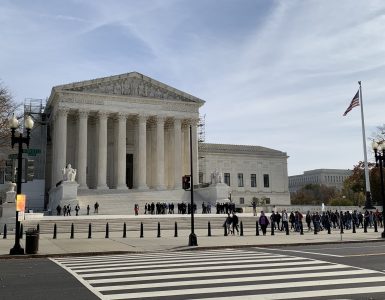In the wake of sudden news that Justice Ruth Bader Ginsburg died on Friday evening, Sept. 18, an impromptu vigil began on the steps of the Supreme Court building. Participants gathered on the steps to sing songs, say prayers, and remember the life of the high court’s liberal icon and her dynamic career that impacted not only politics but American pop culture. Even now, the flowers and candles placed on the steps in her honor are growing in number by the day.
To experience a little of what the vigil was like yourself, listen to the audio embedded below, recorded that night.
Supreme Court Justice Ruth Bader Ginsburg died on Friday, Sep. 18, after losing her final battle with metatastic pancreatic cancer. Ginsburg has battled cancer four times with pancreatic, lung, and colon cancer.
She leaves behind an incredible legacy, not only in her personal life but in the life that she lead as a Supreme Court Justice working to uphold the highest laws of the United States.
Her career at the Supreme Court lasted 27 years as the longest serving woman, but Ginsburg’s career in law as a whole lasted much longer than that in a male-dominated legal culture who did not welcome her.
Ginsburg was born Joan Ruth Bader in Brooklyn, New York on March 15, 1933. She received degrees from Cornell University, Harvard Law School, and Columbia Law School. After teaching at Rutgers University Law School and at Columbia University, she served on the general counsel of the ACLU and its National Board of Directors. She was placed by then President Jimmy Carter to the United States Court of Appeals for the District of Columbia Circuit in 1980 and on June 14, 1993, Ginsburg accepted then President Bill Clinton’s nomination to the Supreme Court.
Many of her most well-known cases tackled issues of women’s rights, discrimination in the workplace and other socially impactful cases. Her first case in 1996 was one that directly challenged the Virginia Military Institute’s all-male admissions policy. The final decision was that the state-funded school would have to shed its misogynistic policy and allow women to attend the institution.
It’s because of her rulings and decidedly feminist views that she began to be heralded as a heroine of womankind and an icon to be admired among many within the feminist movement.
In another case, Chief Justice John Roberts led the majority of the Court in a decision that essentially invalidated a portion of the Voting Rights Act that had forced districts, often in the Southern states, within the nation to undergo federal oversight before altering any voting changes. It was her written dissent in this case that earned her the nickname “Notorious RBG” from an admiring law student which would be touted until her death and beyond as a hallmark for her passion for justice.
She wrote this in her dissent, “throwing out preclearance when it has worked and is continuing to work to stop discriminatory changes is like throwing away your umbrella in a rainstorm because you are not getting wet.”
Ginsburg was at first reluctant to accept the title of notorious, as she found nothing “notorious” about herself or her views. When it was explained to her that the nickname was a derivative of Brooklyn rapper “The Notorious B.I.G.,” – she told her family, “In the word the current generation uses, it’s awesome”.
There are throw blankets, pop art posters, bobblehead dolls, pins, quote books, stickers, biographies, pillows, action figures, coffee mugs, magnets depicting RBG. Scientists even discovered a new kind of praying mantis in 2016 and dubbed it Ilomantis ginsburgae. In 2018, Felicity Jones portrayed Ginsburg in the film “On The Basis Of Sex”.
Ginsburg was also known to wear a variety of dissent collars, used for when she dissented from the majority decision on the Supreme Court, when Justice Kavanaugh was appointed, and when President Trump took office. The collars were often intricate and beautiful in design. Katie Couric once interviewed Ginsburg about her collar collection and asked what they meant to the justice symbolically. Ginsburg told her, “You know, the standard robe is made for a man because it has a place for the shirt to show, and the tie. So Sandra Day O’Connor and I thought it would be appropriate if we included as part of our robe something typical of a woman. So I have many, many collars.”
With the loss of such a liberal icon of the high court, Americans are now looking ahead to the November election and the potential that President Trump will try to appoint a new Supreme Court judge to take Ginsburg’s place.
Ruth Bader Ginsburg will be the first woman in history to be laid in state at the U.S. Capitol this Friday, Sep. 25. in the National Statutory Hall. A private ceremony will be held for family members and friends early Wednesday at the Supreme Court, and the public is invited to honor her on Wednesday from 11 a.m. to 10 p.m. and again on Thursday from 9 a.m. to 10 p.m. under the portico. She will be buried in Arlington National Cemetery next week.















Add comment